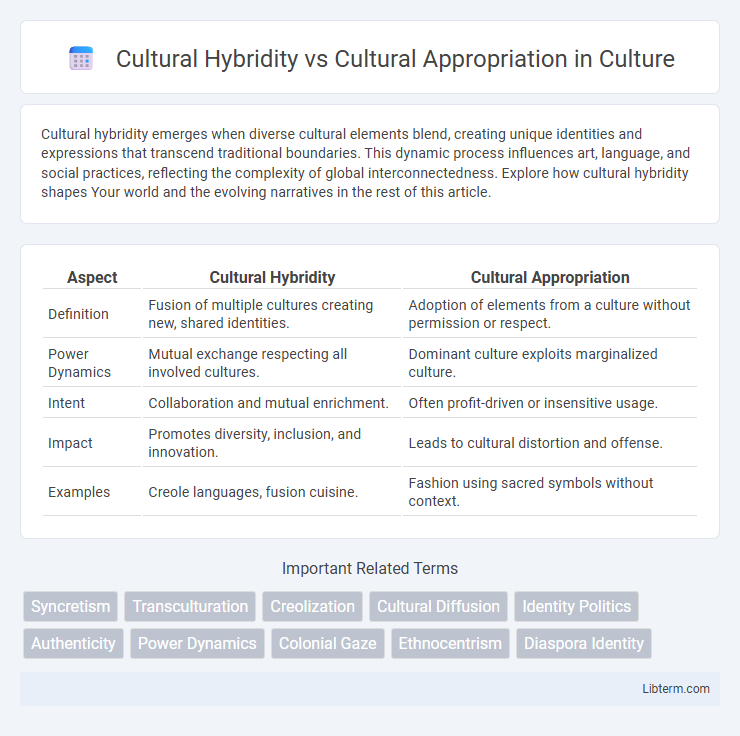Cultural hybridity emerges when diverse cultural elements blend, creating unique identities and expressions that transcend traditional boundaries. This dynamic process influences art, language, and social practices, reflecting the complexity of global interconnectedness. Explore how cultural hybridity shapes Your world and the evolving narratives in the rest of this article.
Table of Comparison
| Aspect | Cultural Hybridity | Cultural Appropriation |
|---|---|---|
| Definition | Fusion of multiple cultures creating new, shared identities. | Adoption of elements from a culture without permission or respect. |
| Power Dynamics | Mutual exchange respecting all involved cultures. | Dominant culture exploits marginalized culture. |
| Intent | Collaboration and mutual enrichment. | Often profit-driven or insensitive usage. |
| Impact | Promotes diversity, inclusion, and innovation. | Leads to cultural distortion and offense. |
| Examples | Creole languages, fusion cuisine. | Fashion using sacred symbols without context. |
Defining Cultural Hybridity
Cultural hybridity refers to the dynamic process where elements from different cultures merge to create new, hybrid identities and expressions, often seen in art, language, and social practices. This concept emphasizes mutual exchange, adaptation, and innovation, contrasting with cultural appropriation, which involves the adoption of cultural elements without understanding or respect, often leading to exploitation. Symbolizing globalization and multiculturalism, cultural hybridity fosters dialogue and coexistence among diverse cultural groups.
Understanding Cultural Appropriation
Cultural appropriation involves adopting elements of a marginalized culture by members of a dominant culture without permission, leading to misrepresentation and exploitation. It often disregards the original context and significance, causing harm and perpetuating stereotypes. Understanding cultural appropriation requires recognizing power dynamics and respecting the cultural heritage and identity of marginalized communities.
Historical Contexts of Cultural Exchange
Historical contexts of cultural exchange reveal that cultural hybridity emerges from mutual interaction and blending of diverse traditions, creating new, dynamic identities. In contrast, cultural appropriation often involves the adoption of elements from marginalized cultures without consent, leading to misrepresentation and power imbalances. Examining colonialism, trade routes, and migration patterns highlights how historical power dynamics influence whether cultural exchange fosters hybridity or appropriation.
Key Differences Between Hybridity and Appropriation
Cultural hybridity involves the mutual exchange and blending of cultural elements resulting in new, shared identities, while cultural appropriation refers to the adoption of specific cultural aspects by a dominant group, often without permission and respect. Hybridity emphasizes collaboration and equal power dynamics, whereas appropriation is marked by power imbalances and the exploitation or misrepresentation of cultural symbols. The key difference lies in intent, context, and power relations underlying the interaction between cultures.
Power Dynamics in Cultural Interaction
Cultural hybridity emerges from the dynamic exchange and fusion of cultural elements, often reflecting mutual influence and respect between groups, whereas cultural appropriation involves the dominant culture exploiting or misusing aspects of a marginalized culture without proper understanding or permission. Power dynamics play a crucial role, with hybridity typically occurring in contexts where cultural interactions are more balanced, while appropriation highlights inequalities where the dominant group benefits at the expense of the subordinated group. The discourse critically examines how historical and social power imbalances shape perceptions of authenticity, respect, and ownership in cultural exchange.
The Role of Intent and Consent
Cultural hybridity emphasizes the blending of cultures through mutual exchange and respect, often fostering innovation and understanding. The role of intent in cultural hybridity is crucial, as it involves genuine appreciation rather than exploitation, distinguishing it from cultural appropriation. Consent from the originating culture ensures ethical engagement, preventing harm and acknowledging the significance of cultural symbols and practices.
Examples of Cultural Hybridity in Contemporary Society
Cultural hybridity manifests in contemporary society through phenomena such as fusion cuisine, where traditional dishes blend ingredients and techniques from multiple cultures, creating new culinary experiences like Korean tacos or sushi burritos. Fashion also exemplifies hybridity by merging elements from diverse cultural backgrounds, as seen in streetwear brands incorporating indigenous patterns alongside modern urban styles. Music genres like reggaeton and K-pop further illustrate cultural hybridity by combining rhythms, languages, and production styles from different regions, fostering global cultural exchange without the exploitative connotations linked to cultural appropriation.
Cases of Cultural Appropriation and Backlash
Cases of cultural appropriation often involve the unauthorized use of symbols, clothing, or rituals from marginalized cultures by more dominant groups, leading to significant backlash from affected communities. High-profile incidents, such as fashion brands adopting Indigenous patterns without consent or celebrities wearing sacred attire as costumes, have sparked widespread criticism for perpetuating stereotypes and commodifying cultural heritage. This backlash highlights ongoing tensions between cultural hybridity, which encourages respectful blending and exchange, and appropriation, which exploits and diminishes the original cultural significance.
Navigating Respectful Cultural Engagement
Cultural hybridity fosters respectful cultural engagement by blending elements from diverse traditions to create new, inclusive expressions that honor their origins. In contrast, cultural appropriation involves adopting cultural symbols or practices without understanding or respecting their significance, often leading to misrepresentation and offense. Navigating respectful cultural engagement requires awareness, sensitivity, and active dialogue to ensure authentic appreciation rather than exploitation.
Future Perspectives on Global Cultural Interactions
Future perspectives on global cultural interactions emphasize the potential of cultural hybridity to foster innovation, social cohesion, and mutual respect by blending diverse traditions and practices in equitable ways. Digital connectivity and increased migration intensify opportunities for hybrid cultures to emerge organically, challenging rigid notions of cultural ownership and authenticity. However, ongoing debates over cultural appropriation highlight the necessity for ethical frameworks that protect marginalized communities from exploitation while promoting intercultural dialogue.
Cultural Hybridity Infographic

 libterm.com
libterm.com